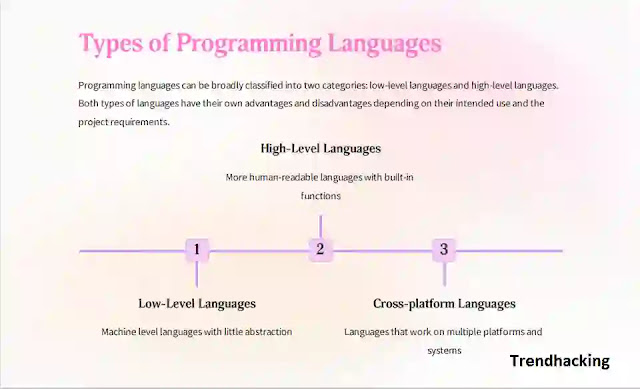Introduction to Programming Languages
Programming languages are formal languages designed to communicate instructions to a computer and enable it to perform specific tasks. They serve as a means for programmers to write code, which is a set of instructions that can be executed by a computer.Programming languages provide a structured and systematic way of expressing algorithms and solving problems. They have different syntax and semantics that dictate how instructions are written and interpreted by the computer.
Popular Programming Languages Today
Here are a few popular programming languages
C: Developed in the early 1970s, C is a general-purpose programming language known for its efficiency and low-level control over computer hardware. It has a simple syntax and is widely used for system programming, embedded systems, and game development.Java: Introduced in the mid-1990s, Java is a versatile, platform-independent language. It follows the "write once, run anywhere" principle, meaning that Java code can run on any device with a Java Virtual Machine (JVM). Java is used in a variety of applications, including web development, mobile apps, enterprise software, and more.
Python: Python is a high-level programming language known for its readability and simplicity. It emphasizes code readability and provides a large standard library that makes it easy to accomplish common programming tasks. Python is widely used in web development, data analysis, machine learning, and scientific computing.
JavaScript: JavaScript is a popular scripting language primarily used for web development. It allows dynamic and interactive elements to be added to websites, making it essential for front-end web development. JavaScript can also be used for server-side development (Node.js) and cross-platform desktop or mobile app development.
C++: C++ is an extension of the C programming language, adding object-oriented programming (OOP) features. It is a powerful language used in performance-critical applications, game development, and system programming. C++ is known for its efficiency and ability to directly manipulate hardware resources.
Ruby: Ruby is a dynamic, object-oriented scripting language that focuses on simplicity and productivity. It has an elegant syntax and is often associated with web development using the Ruby on Rails framework. Ruby emphasizes developer happiness and is known for its ease of use.
 |
| popular programming language |
Types of Programming Languages
Programming languages can be classified into several types based on different criteria. Here are some common classifications of programming languages:
High-Level Languages: High-level languages are designed to be human-readable and closer to natural language than machine code. They provide abstractions and built-in functions to simplify programming tasks. Examples include Python, Java, Ruby, and JavaScript.
Low-Level Languages: Low-level languages are closer to machine code and provide more direct control over hardware resources. They are often used for system programming and device drivers. Examples include Assembly language and languages like C and C++ that allow low-level programming.
Procedural Languages: Procedural languages follow a procedural programming paradigm, where the program is divided into procedures or subroutines that perform specific tasks. These languages focus on explicit instructions and step-by-step execution. Examples include C, Pascal, and Fortran.
Object-Oriented Languages: Object-oriented languages (OOP) organize code around objects that encapsulate data and behavior. They provide concepts like classes, inheritance, and polymorphism, promoting modular and reusable code. Examples include Java, C++, Python, and Ruby.
 |
| Programming languge |
Resources for Learning Programming Languages
Online Tutorials and Documentation: Many programming languages have official websites that provide comprehensive tutorials, documentation, and guides. These resources often cover language syntax, concepts, and best practices. Examples include Python's official documentation (https://docs.python.org), Java Tutorials (https://docs.oracle.com/javase/tutorial/), and JavaScript MDN Web Docs (https://developer.mozilla.org/en-US/docs/Web/JavaScript/Guide).
Online Learning Platforms: Websites like Udemy (https://www.udemy.com), Coursera (https://www.coursera.org), and edX (https://www.edx.org) offer a wide range of programming courses, both free and paid. These platforms provide structured courses with video lectures, exercises, and quizzes, allowing you to learn at your own pace.
Programming Books: Books are an excellent resource for in-depth learning. There are numerous programming books available, covering various languages and topics. Some popular book publishers include O'Reilly Media (https://www.oreilly.com), Manning Publications (https://www.manning.com), and Apress (https://www.apress.com).
 |
| programming language |
No comments:
Post a Comment